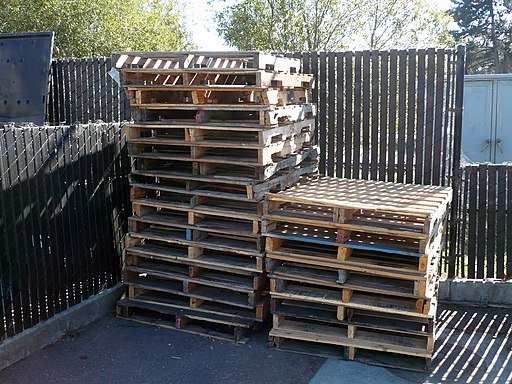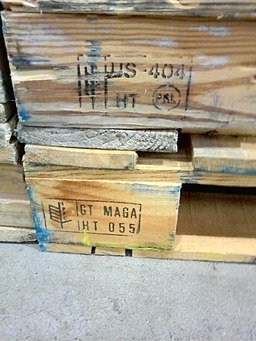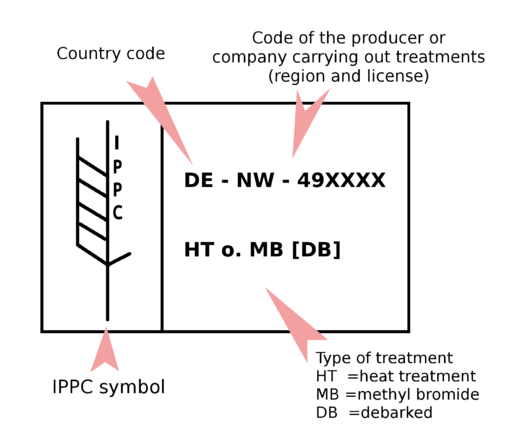Are Heat Treated Pallets Safe For Gardening
Are Reclaimed Pallets Safe For Gardening?
As a frugal beginning homesteader, I am constantly on the lookout for cheap ways to build new infrastructure. Indeed, one of the reasons that we have chosen to move so slowly into the homestead lifestyle is the expense involved in just diving in. But for me, that is part of the allure of it all. I am inspired by the challenge of building a lifestyle where my family and I consume less. One widely available and cheap - sometimes even FREE resource that I am interested in using is the shipping pallet.

Image Credit: Ellin Beltz [CC BY-SA 3.0 (https://creativecommons.org/licenses/by-sa/3.0)]
Shipping pallet projects are all the rage right now with cool ideas and templates popping up all over the internet: everything from furniture to garden beds to cutting boards. But, just how safe is it to use pallets for items that will be in such intimate contact with us or our food?
The Dangers
When it comes to pallets, it is very important to pay attention to what you are getting. In the past, some pallets have been treated with pretty toxic chemicals in order to kill pests in the wood and prevent them from spreading into non-native habitats. The main offender is an acutely dangerous chemical called methyl bromide; however, the use of methyl bromide has been suspended in the US for most applications (including fumigating pallets) since 2005.
Now, most pallets are heat treated, which means that they are heated in a kiln to a core temperature of 56 C (132.8 F) for 30 minutes. This treatment is enough to kill any organisms living in the wood without making it toxic.

Image Credit: self-made by the uploader [CC BY-SA 2.5 ca (https://creativecommons.org/licenses/by-sa/2.5/ca/deed.en)]
Choosing The Right Pallets
After nearly 15 years, you would probably be pretty hard pressed to find any pallets fumigated with methyl bromide, but they may still be out there. So, how do you know if a pallet it safe to use for your project?
In 2002, the International Plant Protection Convention (IPPC) created the ISPM-15 to regulate the wood used for packaging material utilized in international trade. It sets forth international guidelines for the treatment of wood used in shipping containers in an attempt to prevent the spread of wood pests that would be detrimental to forest land. To ensure efficacy of the program, the IPPC also requires that all compliant shipping containers be marked with symbols showing the IPPC logo, the country where the pallet was made, the method used to treat the wood, and the facility that treated the pallet.

Image Credit: Penyulap [CC BY-SA 3.0 (https://creativecommons.org/licenses/by-sa/3.0)]
For the savvy pallet DIYer, this stamp should be the first thing you look for. You will be looking for pallets stamped with HT, signifying that the wood was heat treated. If you find a pallet marked MB (Methyl Bromide), you should consider not using it and finding a facility that can dispose of it properly. You should definitely not use it for firewood, furniture, or food projects. It is also advised that you should not use a pallet that does not bear the IPPC stamp. Not every country has adopted the ISPM-15 regulations, and it is possible for pallets from those countries to slip into the borders, and you have no way of knowing how or if they were treated.
Once you have a few pallets that you know have been heat treated, the next thing you should think about is the history of that pallet. Remember, these things are used for shipping freight internationally. There is no way of knowing what has been on a pallet or where it has been before arriving in your garage, so the best you can do is make a guess based on the condition of each individual pallet. If a pallet is discolored or has any type of residue on it, that is a good indication that something may have spilled on it. You may not want to use that one for your food, furniture, or firewood. But, even if the pallet looks clean and new, there is no guarantee that it is unsoiled. You have to make the decision as to whether or not you want to use pallet lumber for your project.
Prepping Your Pallets For Project Use
So, you've found a few pallets that you are confident in. The next thing you'll need to do is prep them for use. At this point, you should probably be wearing gloves while working with your project pallets. Those things are known for harboring bacteria and mold, and you don't want a big ole splinter inoculating you with something like E. coli. You also don't want something like E. coli growing on your furniture or where you harvest your veggies, so it is probably a good idea to clean and disinfect your pallet lumber before beginning your project. You can do this with hot soapy water or bleach and a scrub brush. Sure, it's an extra step, but the extra time and effort should pay off in peace of mind knowing that people aren't going to get sick after eating that tomato or contract some crazy flesh eating disease after sitting in your chair. After cleaning your pallets, you should allow them to sun dry. Once they are dry, you may choose to sand them down to prevent splinters (especially if you are building furniture). If so, be sure to wear a mask so you don't inhale all of that saw dust. Now, you're ready to break your pallets down and get started on that project of yours! And, when you're finished, I'd love to see it! Drop a picture down in the comments; or better yet, make a blog post about your project and drop a LINK to it down in the comments!

Are Heat Treated Pallets Safe For Gardening
Source: https://steemit.com/palnet/@sustainablyyours/are-reclaimed-pallets-safe-for-gardening
Posted by: stokesfrighters.blogspot.com

0 Response to "Are Heat Treated Pallets Safe For Gardening"
Post a Comment